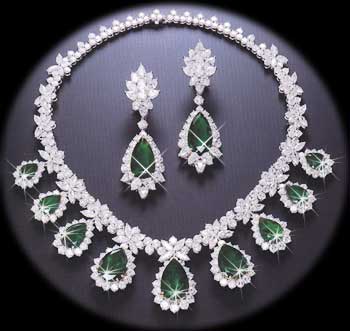Generally, the Italians offer brilliant, bold gold with interesting links, gem treatments and colors. They prefer polished gold to matte gold, but some are beginning to experiment with textures. Many designs feature diamond pave accents or large sections of pave as a design element. Bi-color and especially tri-color gold is the biggest trend among the Italian designers. Most notable among the Germans are earrings, pins, slim collars and eyeglasses. The Germans seem to have mastered the art of simple but attractive earrings, often priced well for the women’s self-purchase market. The predominant style has a long, slim dangle, formed by putting a geometric design element on a post, attaching a long wire or tube, and finishing with a matching or complementary element. Earrings have movement and length, usually from about chin to mid-neck. Hoops with danglers also available.
The long, slender look continued in many pins is the kind which looks best on a lapel, against a plain sweater, suspended from a single wire choker or holding a scarf in place. Most pins are gold, many mixing yellow and white gold or yellow gold and platinum; some have diamond accents. The Germans use a lot of matte gold and platinum, as well as hammer-set diamonds. They usually favor smaller and fewer diamonds per piece than the Italians; often just one diamond serves as the focal point of a piece. Slim round wire or leather collars with a geometric design element hanging front and center are very popular. The theme is repeated in round hoop earrings inserted through the center of a hanging charm. Karat gold eyeglasses, often set with gemstones, are a distinctly European trend. German, Austrian and Greek jewelry manufacturers all offer them. Franz Fialka, an Austrian firm, said Americans haven’t yet caught on to the trend. The jeweled frames are approved for use with prescription lenses. Although Idar-Oberstein is a major gem-cutting center and Germans Bernd Munsteiner and Dieter Lorenz are world-renowned gem-cutting pioneers, the Germans don’t use many colored stones in their jewelry designs. They prefer to stick to the yellow and white look of gold, platinum and diamonds. Such design tends to appeal to western European tastes. |  |